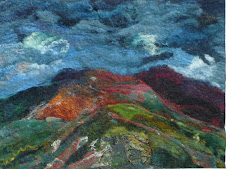
Both the DS's have gone back to normal life one to job and v.busy social life, and the other to finish his PH.D. DH has gone off to work so as soon as I could I went to investigate the "inks" I had made before Christmas. I had put a tablespoon of dye chips, except for the saffron which was 1g , added 100ml of water and put them into jam jars in the slow cooker which were making dyebaths for 48 hours or so. Then I filtered them through coffee filter papers into glass spice jars and left them till today.
Left Column top to bottom. Saffron, Cutch, Walnut with iron added, logwood with iron added ( surprising! and I have now added some washing soda to get purple).
Right Column. Cochineal with tin added after filtering & ammonia. Cochineal with iron & ammonia, Black oak -disappointing as an "ink" ,Cochineal with tin added at the soaking stage.
You can see from these samples how watery and runny the " inks/paints" ( I am not sure what to call them!) are so I thought that I would try and see what "stabalising" with gum arabic means. ( see previous post)
I hunted out some old dusty gum arabic and tried to find a reference in my dye books to using it. I am sure Liles has it in but could I find my Liles? Could I heck. In the process I found I have no less than two copies of Bemiss! Who is not a lot of use in this case. Nor were my other dye books although I must confess my search was a bit cursory. There was nothing in Cardon, nor in Jenny Dean's, nor in Susan Bosence books for example although I am sure I have seen a recipe somewhere.
I tried dissolving a few lumps of gum arabic in water in my studio microwave , but in the end heated them, stirring in a small pan till no more would dissolve and then added the resulting solution to my "inks". It did not make much difference and in the end I added in the order of 1 tablespoon of gum arabic solution to 50ml of " ink". I was planning to go back after I had eaten but succumbed to the temptation of watching The Titanic sink on BBC2-why I cannot think as it is a lousy film apart form the sinking bit which is quite dramatic so I put it down to being still post bug as as my legs still feel a bit jelly like it will have to do as an a excuse. So I will have to wait till tommorow to see whether I think there is any improvement . I have painted with dye thickened with gum tragacanth which makes a sort of textured paint so it will be interesting to see the difference between the different types of thickener.




































